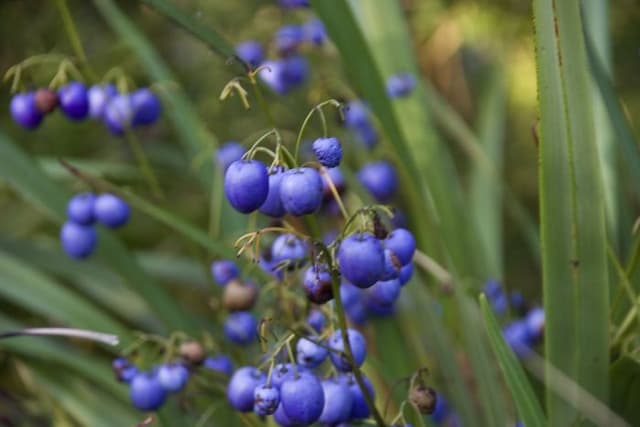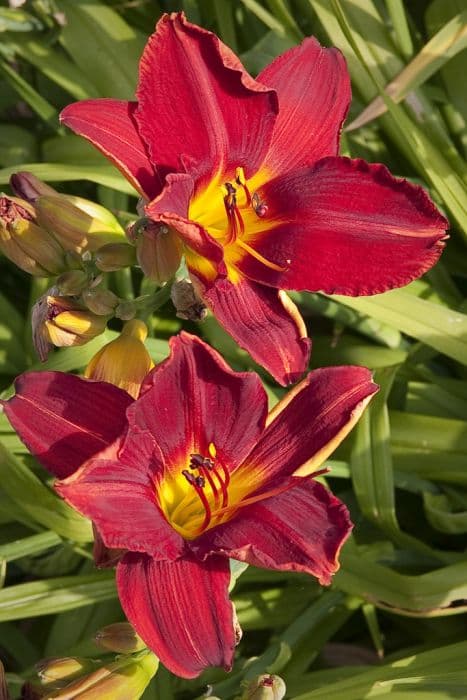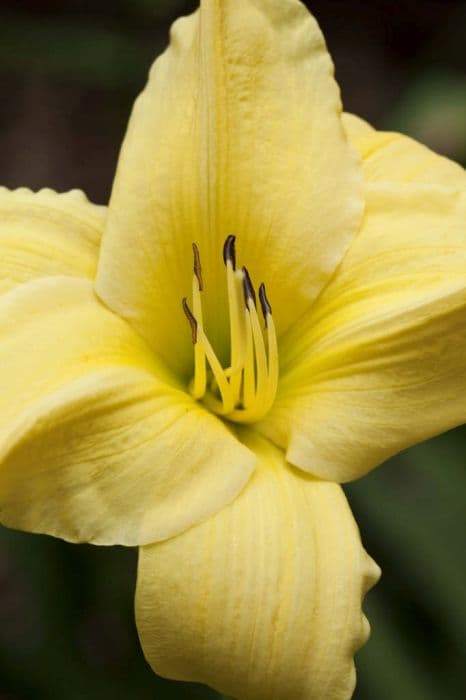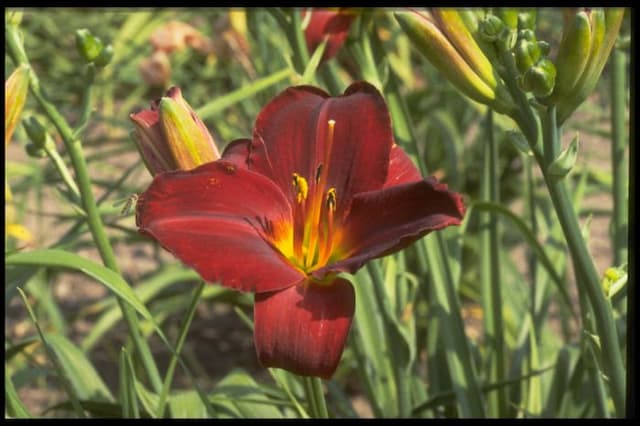Daylily Hemerocallis 'Irish Elf'

ABOUT
The Hemerocallis 'Irish Elf', commonly known as a Daylily, is a perennial plant known for its vibrant and attractive flowers. This variety features charming blooms that are notable for their delicate appearance. Each flower presents a bright, lemon-yellow color, with petals that are gracefully ruffled along the edges, adding a touch of elegance to the already striking flower. The throat of the flower—the central part visible inside the petals—is typically a slightly paler shade, enhancing the depth and allure of the blossoms. The flowers of the Daylily ‘Irish Elf’ are trumpet-shaped, a characteristic form for Daylilies, and they stand out against the green, strappy foliage that is lush and forms a dense clump. The foliage consists of long, narrow leaves that arch gracefully and provide a verdant backdrop for the enchanting flowers. These leaves can vary in texture but commonly have a smooth and sometimes slightly ribbed surface that adds interest to the plant’s overall texture. Daylilies are known for their individual flowers blooming for just one day, but ‘Irish Elf’ produces multiple buds that ensure a succession of flowers, providing a prolonged display of its delightful yellow blossoms. The plant tends to have a compact growth habit, with the flowers rising just above the foliage on slender, upright stems that sway gently in the breeze. Overall, Hemerocallis 'Irish Elf' is a captivating addition to any garden space, offering a burst of sunny yellow and softening the landscape with its mounded foliage and undulating flower edges. It captures the attention of onlookers with its petite and bright flowers and is sure to bring cheerful color to the garden when in bloom.
About this plant
 Names
NamesFamily
Hemerocallidaceae
Synonyms
Daylily
Common names
Hemerocallis 'Irish Elf'
 Toxicity
ToxicityTo humans
Daylilies such as the Hemerocallis 'Irish Elf' are not generally considered toxic to humans. In fact, some species within the daylily family are edible and used in culinary dishes, particularly in Asian cuisines. However, as with any plant not commonly consumed, individual allergies or sensitivities could potentially cause gastrointestinal discomfort if ingested. It is always advisable to be cautious and refrain from consuming any part of ornamental plants unless they are known to be edible and you have confirmed you do not have any specific allergies or sensitivities to them.
To pets
Daylilies, including the Hemerocallis 'Irish Elf', are known to be toxic to cats. Ingesting any part of the plant can lead to symptoms such as vomiting, lethargy, inappetence, and more seriously, kidney failure. The exact toxic component is not well understood, but it can cause severe health implications in cats. If you suspect your cat has ingested part of a daylily plant, immediate veterinary attention is required. Daylilies are generally not considered toxic to dogs, but ingesting large amounts could potentially cause mild gastrointestinal upset.
 Characteristics
CharacteristicsLife cycle
Perennials
Foliage type
Deciduous
Color of leaves
Green
Flower color
Yellow
Height
1 foot 6 inches [45.72 cm]
Spread
1 foot 6 inches [45.72 cm]
Plant type
Herb
Hardiness zones
3-9
Native area
Asia
Benefits
 General Benefits
General Benefits- Easy to grow - Hemerocallis 'Irish Elf' is known for being a hardy plant that can thrive in a variety of soil conditions and climates.
- Low maintenance – This daylily variety requires minimal care, making it ideal for both novice and experienced gardeners.
- Drought resistant – Once established, it has good tolerance for dry periods, reducing the need for frequent watering.
- Attracts pollinators – The bright, colorful flowers are attractive to bees and butterflies, promoting a healthy garden ecosystem.
- Long blooming period – Hemerocallis 'Irish Elf' produces flowers that bloom over a long period, providing extended visual interest throughout the growing season.
- Versatility in landscaping – It can be used in a variety of ways, including in borders, flower beds, and as ground cover, making it a flexible choice for garden design.
- Rapid growth – This plant tends to grow quickly, filling in garden spaces and providing a lush appearance in a shorter period.
- Multiplication – The plant naturally multiplies, offering gardeners the opportunity to divide and expand their garden or share with others.
- Deer resistance – Hemerocallis 'Irish Elf' is not a preferred choice for deer, which can help protect your garden from browsing damage.
 Medical Properties
Medical PropertiesThis plant is not used for medical purposes.
 Air-purifying Qualities
Air-purifying QualitiesThis plant is not specifically known for air purifying qualities.
 Other Uses
Other Uses- Bioindicator plant: Irish Elf can be used to monitor environmental conditions, such as soil health and the presence of certain pollutants, as changes in its growth can indicate varying conditions.
- Erosion control: With its fibrous root system, this daylily can be planted on slopes or areas prone to erosion to help stabilize the soil and prevent runoff.
- Photography: Due to its vibrant colors and graceful form, the Irish Elf variety is often used as a subject in plant and garden photography.
- Artistic inspiration: Artists may use the striking appearance of Irish Elf daylilies as inspiration for paintings, illustrations, and floral designs.
- Culinary garnish: The non-toxic blooms of Irish Elf can add an ornamental touch to plates and platters in culinary presentations.
- Educational tool: Gardeners and educators can use Irish Elf to teach about plant biology, hybridization, and horticulture due to its distinct characteristics.
- Dye production: The petals of Irish Elf can be used to create natural dyes for textiles or craft projects.
- Companion planting: This daylily can be used in companion planting to attract beneficial insects or to provide shade for lower-growing, shade-tolerant plants.
- Wastewater treatment: Some daylilies are used in constructed wetlands for wastewater treatment; Irish Elf could potentially contribute to this process by taking up excess nutrients.
- Mood enhancement: Due to its aesthetically pleasing appearance, Irish Elf can be used in horticultural therapy settings to improve mood and reduce stress.
Interesting Facts
 Feng Shui
Feng ShuiThe plant_name is not used in Feng Shui practice.
 Zodiac Sign Compitability
Zodiac Sign CompitabilityThe plant_name is not used in astrology practice.
 Plant Symbolism
Plant Symbolism- Daylily: The common name for Hemerocallis is daylily, so-called because each bloom lasts for only one day. Symbolism associated with daylilies includes the ephemeral nature of life, reminding us to cherish each moment as it comes and goes.
 Water
WaterDaylilies, including the Hemerocallis 'Irish Elf,' should be watered deeply once a week, providing about one to one and a half inches of water which equates to roughly 0.6 to 0.9 gallons per square yard of soil. This frequency should be increased during hot, dry periods to ensure the soil remains moist but not waterlogged. It is important to avoid overhead watering to minimize the risk of leaf spot diseases. During the winter months or in cooler climates, reduce watering as the plant requires less moisture. Consistent watering is key to maintaining lush foliage and vibrant blooms.
 Light
LightDaylilies, specifically the Hemerocallis 'Irish Elf,' thrive in full sun to partial shade locations. They need a minimum of six hours of sunlight each day to perform best, but can tolerate some afternoon shade, especially in hotter climates. The ideal spot would be one where they can bathe in the morning sun and be protected from the harsh late afternoon light, which aligns with their preference for cooler temperatures.
 Temperature
TemperatureThe Hemerocallis 'Irish Elf' daylily is quite adaptable and can tolerate a wide temperature range, but the ideal growing temperatures are between 60 and 70 degrees Fahrenheit. They can survive in temperatures as low as 20 degrees Fahrenheit and as high as 90 degrees Fahrenheit. To ensure vigorous growth and blooming, keep them protected from extreme cold and heat.
 Pruning
PruningThe Hemerocallis 'Irish Elf' daylily benefits from pruning to remove spent flowers and dead foliage, which encourages reblooming and maintains a neat appearance. Deadheading the flowers as they fade can promote a second bloom cycle. The best time for pruning is after the bloom period, usually in late summer or early fall. Annually cut back the foliage to the ground in late fall or early winter to prepare for the growing season ahead.
 Cleaning
CleaningAs needed
 Soil
SoilDaylilies including 'Irish Elf' prefer well-drained soil with ample organic matter; a mix of loamy soil, compost, and perlite can be ideal. Maintain soil pH between 6.0 to 6.5 for optimal growth.
 Repotting
RepottingDaylilies like the 'Irish Elf' seldom require repotting, as they are typically grown in the ground; divide clumps every 3-5 years to prevent overcrowding.
 Humidity & Misting
Humidity & MistingDaylilies, such as the 'Irish Elf', are tolerant of a wide range of humidity levels and do not require any specific humidity conditions to thrive.
 Suitable locations
Suitable locationsIndoor
Place in bright indirect light and maintain moderate temperatures.
Outdoor
Full sun to partial shade with well-draining soil is best for growth.
Hardiness zone
3-9 USDA
 Life cycle
Life cycleThe Daylily 'Irish Elf' begins its life with seed germination, typically in spring or early summer, where warmth and moisture trigger the development of the root system and shoots. The sprouts then develop into young plants with foliage forming a fan-shaped clump. As the plants mature, they form a robust root system and increase in size and foliage each year, readying themselves for the blooming phase. Flowering occurs in early to mid-summer, with each bloom lasting only one day, a trait typical of daylilies. Following pollination, either naturally or artificially, seeds may be produced in pods, but many gardeners propagate 'Irish Elf' vegetatively by dividing the clumps every few years to maintain vigor. After the flowering season, the plant continues to photosynthesize and store energy before entering dormancy in the winter, only to resume growth in the following spring.
 Propogation
PropogationPropogation time
Late Summer to Fall
The daylily, known scientifically as Hemerocallis 'Irish Elf', can be propagated effectively by dividing the plant. The best time to divide daylilies is early spring or late fall when the plant is not in active growth. The most popular method of propagation is by division, which involves carefully lifting the clump from the soil and gently separating the fans of leaves, each with their own roots. Use a sharp knife or spade to cut through the thick roots if they do not come apart easily. After dividing, replant the divisions at the same depth they were previously growing and water them well. This helps to maintain the health of the plant and encourages a flush of new growth in the following season.









